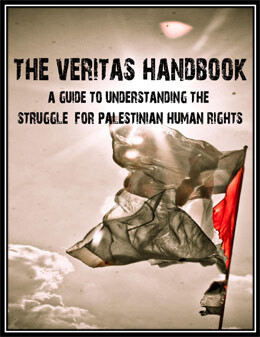The Electronic Intifada 9 August 2010

Categorized as “a guide to understanding the struggle for Palestinian human rights,” The Veritas Handbook was released in late July 2010 by a five-person team of college students and recent graduates from multi-ethnic, multi-religious and various solidarity movement backgrounds in the United States and Canada. The editors say the project was truly a grassroots initiative, as everyone worked on a “zero budget” — neither receiving nor paying any money to compile the handbook.
Preceded by a page of tongue-in-cheek acknowledgments to Israeli propaganda tools — the Hasbara Handbook and the Hasbara Fellowships, and the Israel Project’s Global Language Dictionary, “both of which served as great inspirations, convincing us of the necessity of this handbook in our plight to establish truth and justice” — The Veritas Handbook begins with a detailed orientation of the socio-political landscape and a timeline of the modern history of Palestine and Israel. Key facts and figures are identified, weaving a platform of context that the mainstream media and most North American textbooks omit.
From explaining Israeli and Palestinian political parties, officials, and their platforms, to discussing Lebanon’s interwoven role in the Palestinian struggle, to a section on the impact of the 2009 UN-commissioned Goldstone Report, the book runs through the last century and a half debunking racist myths and dissecting information down to its core context without promoting a particular political or nationalist narrative, an editor told the Electronic Intifada (EI).
“We merely sought to present the relevant facts and events necessary for an understanding of the Palestinian struggle for human rights, rather than to justify any political position,” said Vancouver-based editor Fatemah Meghji, 21, a recent graduate of the University of British Colombia.
“Although there’s a plethora of amazing resources out there, few are really aimed at providing an overview of information to activists or providing a contextualization of the human rights struggle. This is what The Veritas Handbook seeks to accomplish,” Meghji added.
Throughout the book, conventional wisdom on Palestine as commonly represented in mainstream media is frequently challenged and debated. Meghji said that the unique third section of the handbook, entitled “Perspectives,” aims to “inform activists of the controversial and internal debates and implications on what each individual [political and resistance] strategy promotes.”
“Some of the issues raised in this section include non-violent versus violent resistance, debates about Israel’s ‘right to exist,’ the question of ‘dialogue,’ and the complications of charity work when Palestine is becoming increasingly aid-dependent instead of self-sustaining,” Meghji remarked. “These are all issues that are of critical importance, but rarely are those concerned with Palestine educated on them. We’ve tried to bring together resources and information that we have found valuable in our own solidarity work and make it as useful — and as accessible — as possible for others.”
“We have all worked on the ground extensively and through our experiences, we think we have a firm grip on what’s needed in solidarity work. This handbook, therefore, combines the legal, historical, and human rights ‘textbook’ with the equally-important field work and experience of activism in order to provide a comprehensive perspective on Palestinian human rights.”
Reading material to support The Veritas Handbook’s educational sections include excerpts of published articles by some of the most astute political analysts and commentators on Palestine, Israeli policies and grassroots activism. EI’s co-founder Ali Abunimah, law professor George Bisharat, historian Norman Finkelstein, and members of the Israeli Committee Against House Demolitions, among many others, are featured.
Additionally, there is an in-depth section devoted to the international boycott, divestment and sanctions (BDS) movement that includes over a dozen pages of extensive explanation of the growing — and effective — Palestinian-led initiative.
With extensive maps and a fully-hyperlinked resource list and bibliography, as well as full-color photographs gleaned from some of the best photojournalists working in Palestine today, The Veritas Handbook is visually and informationally comprehensive for activists, researchers and educators alike.
“Our primary goal in this effort is really just to emphasize the importance of education and educating our activists, as this is a problem that we have seen too often,” Meghji said. “We’re hoping that it makes being educated something easy for activists and, furthermore, we hope that the resources in the appendix will serve to make research and activities easier for the Palestine solidarity initiative.”
Because The Veritas Handbook is published for free online, the editors told EI they hope it will encourage readers to distribute it freely and print the parts that they feel are most useful to their local, national and international activist campaigns.
Meghji pointed to at least one pro-Israel website expressing concern that the handbook was already “very viral.” “We think this speaks for itself as far as whether or not the electronic format is effective,” she said.
An updated version of the handbook has already been released this week.
For more information, and to download The Veritas Handbook, visit http://www.veritashandbook.blogspot.com/.

